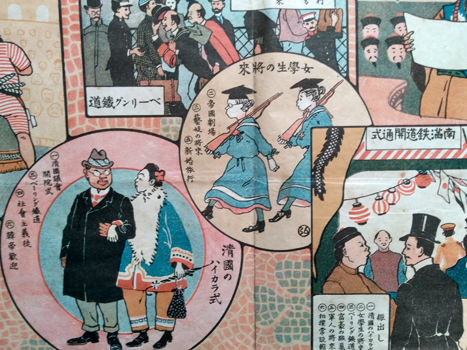
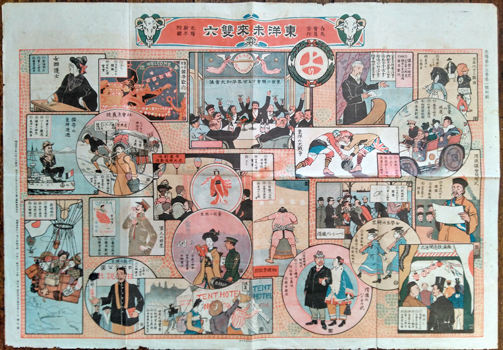
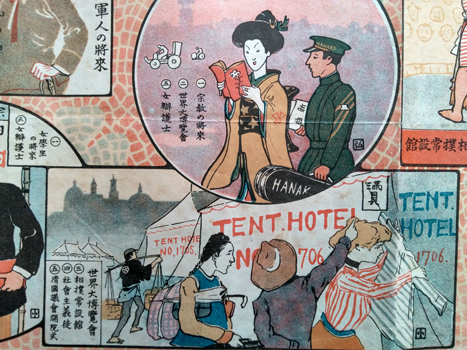
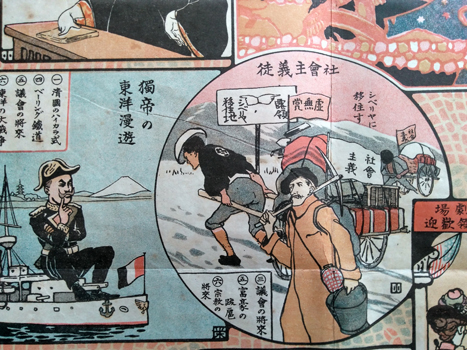

Nakazawa Hiromitsu, Kobayashi Shokichi & Okano Sakae. [Toyo Mirai Sugoroku]. Tokyo, Hakubunkan 1907 (Meiji 40). Colour printed broadside, 55x78cm. Edges nibbled, a small ink splodge, a bit browned; quite good. Au$425
A view, or a panoply of views, of a future Asia. Some of these vignettes of what's to come are obvious enough - schoolgirls at rifle drill and sumo wrestlers in striped bathers - but a few seem fairly recondite to me. I'm not sure how much is optimistic, how much is dire warning and how much is wearily stoic.
Nakazawa, Kobayashi and Okano, still young, had been fellow students at the Tokyo School of Fine Arts, and of Kuroda Seiki, and collaborated on the five volume Nihon Meisho Shasei Kiko, issued over several years.
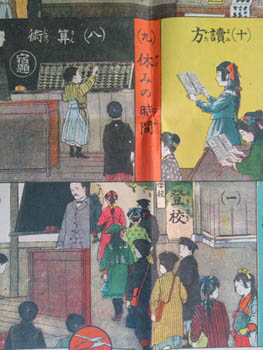
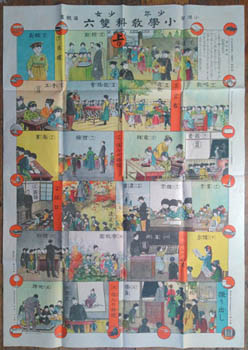
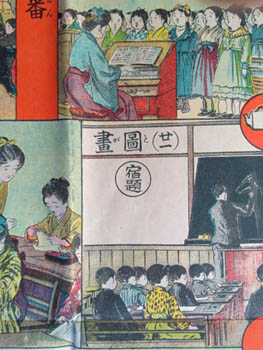
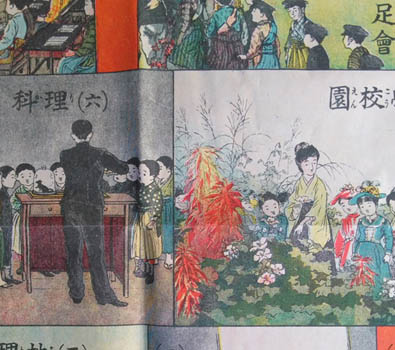

Otake Kokkan. [Shogaku Kyoka Sugoroku]. Tokyo, Shonen Sekei 1907 (Meiji 40). Colour broadside 78x54cm. Quite a nice copy. Au$385
School life for small boys and girls; this was the new year gift from the boys' magazine Shonen Sekai. Boys and girls learn to read but then their ways seem to part: boys learn about rats while girls do flowers, boys learn to count while girls sew, boys write while girls fold paper.
Otake by 1907 was a well regarded, prize winning, Nihonga painter who was firm about maintaining Japanese tradition but like many such artists was a busy producer of prints and illustrator of magazines, books and advertisements.

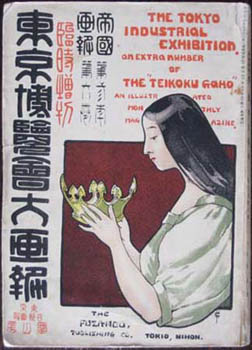

Exhibition - Tokyo 1907. The Tokyo Industrial Exhibition, an extra number of the 'Teikoku Gaho', an illustrated monthly magazine. Tokyo, Fuzanbo [1907]. Quarto publisher's colour illustrated wrapper (a bit used); profusely illustrated throughout, mostly photo illustrations, a few folding, two folding maps, some colour lithographs, including a folding plate of caricatures and an odd depiction of the 'patron goddis of industry'; interspersed sections of advertising on red paper. Au$300
A substantial and very useful round-up of the exhibition; there is a summary in English and the illustrations have English captions. The 1907 exhibition was conceived as an international exhibition but this ambition fizzled due to lack of enthusiasm, if not nerve, on the part of officialdom. Nonetheless this was big stuff, expansive in its inclusion of technology, culture, the arts and popular entertainment - introducing not one but two ferris wheels to Tokyo. And it did pretty good business, apparently atttracting some six or seven million visitors.
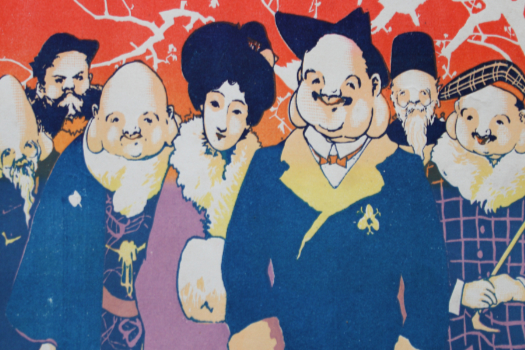
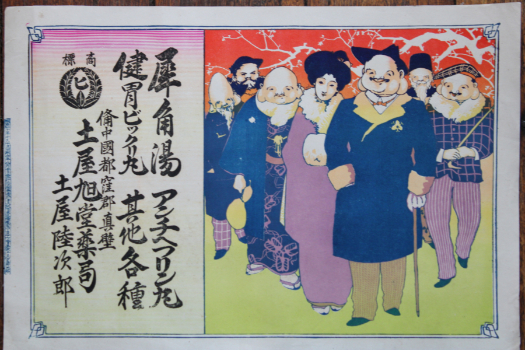

Hikifuda. [Tsuchiya Rikujiro]. Osaka 1907 (Meiji 40). 26x38cm colour lithograph. A nice copy. Au$100
You'd think this smug gang of dandies - the seven lucky gods - would be advertising fashion but they are peddling some sort of pharmaceuticals made by Tsuchiya Rikujiro out of Tsukobo in the Okayama area. The drug trade is treating them well.
Hikifuda - small posters or handbills often handed out as seasonal gifts - were usually produced with the text panel blank. The customer, usually a retailer, had their own details over printed, so the same image might sell fine silk or soy sauce.

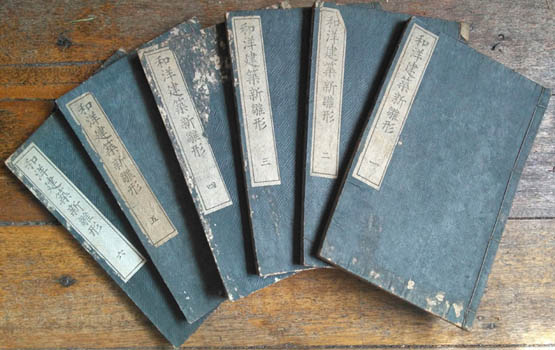
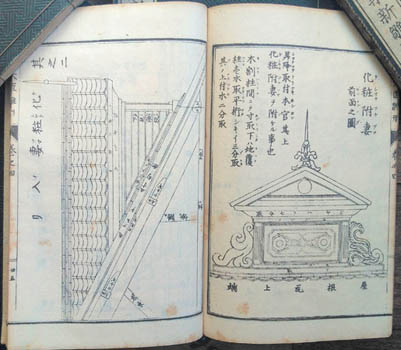
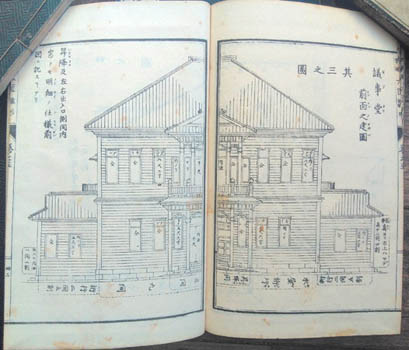

Kameda Yoshiro (or Kichirobei). [Wayo Kenchiku Shin Hinagata]. Osaka, Seikado 1907 (Meiji 40). Six volumes 22x15cm, publisher's wrappers with title labels; illustrated throughout with plans, elevations, measured drawings etc. Wrappers with some surface rubbing or insect grazing; a pretty good set. Au$850
I'm not sure whether this should be described as Japanese principles applied to western design or the other way round. I think both, if it matters. An excellent builder's pattern book that was certainly put to wide use.
There is a 2008 learned paper by Yanigasawa and Mizoguchi that shows how Kameda introduced Japanese carpentry and the modular system into western design but all except the precis of their paper is in Japanese so I have no idea how they go about proving their point. They do tell us that Kameda was a master carpenter in Fukuoka.
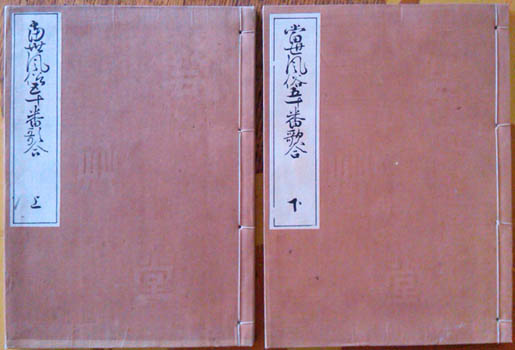
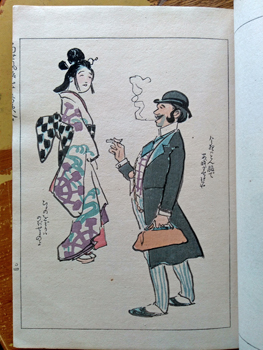

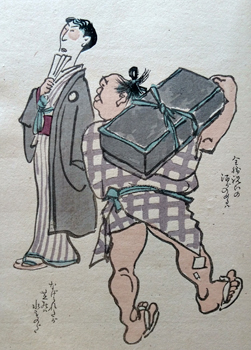

Asai Chu. [Tosei Fuzoku Gojuban Utaawase]. Tokyo, Yoshikawa Hanschichi 1907 (Meiji 40). Two volumes 25x18cm publisher's wrapper with title labels; 52 full page colour woodcuts by Asai. An outstanding pair. Au$1500
Such a fresh and crisp copy of the original edition that I can't bring myself to flatten these out enough to photograph the interior. So the illustrations here, apart from the covers, are from another copy, almost as good, to give an idea of the charm and humour of Asai's observations of the modern Japanese seen in pairs but not necessarily couples. Each of these illustrations accompanies a poem on modern customs; the book's title calls this a poetry competition.
Asai, elder and teacher of the school of western painting, fortunately never abandoned the tradition of satirical illustration. This was published just before his death. Each of these illustrations accompanies a poem on modern customs; the book's title calls this a poetry competition.
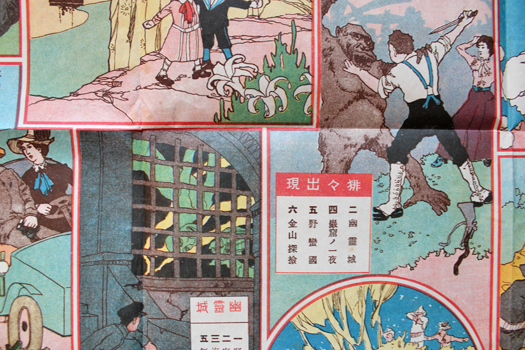


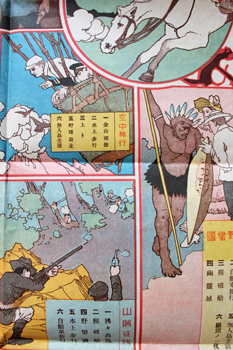

Kosugi Misai. [Boken Soyu Sugoroku]. Tokyo, Hakubunkan 1908 (Meiji 41). 54x80cm colour printed broadside. Mild signs of use, rather good with the playing pieces in the top margin. Au$450
This stylish adventure sugoroku was the new year gift from the magazine Boken Sekai (Adventure World). A thrill seeking family jaunt around the world meeting sea serpents, sirens and ghouls of some sort, killing all sorts of large beasts on the way. Only father and the older son get to kill things but mother does get to drive a car, radical enough.
Kosugi Misai was another of those painters who started by studying western art and discovered Japanese art outside Japan; in his case in Paris in 1913.
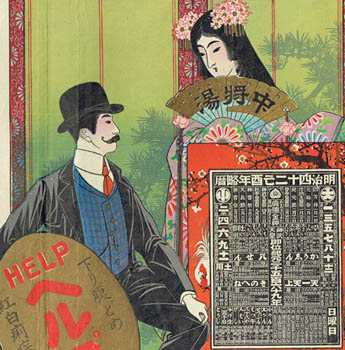
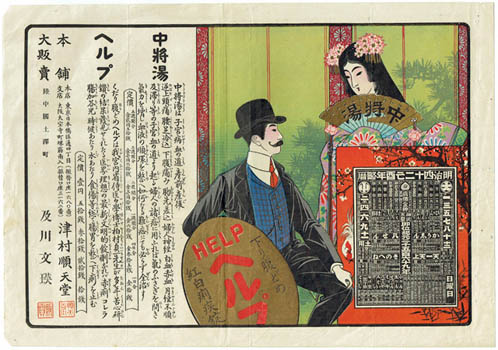

Hikifuda. Tsumura Juntendo. - [Chujo Yu - Herupu]. [Tokyo? 1908-09]. Colour lithograph 265x375mm. Old vertical folds, stabholes in the right margin and tips clipped from the left corners indicating it was once part of an album. A pretty good copy. Au$225
Tsumura Juntendo - still in business - began selling herbal remedies in Tokyo in the 1890s and 'Help' - Tsumura's herbal wonder cure for women - went on the market in 1907. This handsome hikifuda - handbill or poster - includes a calendar for 1909.
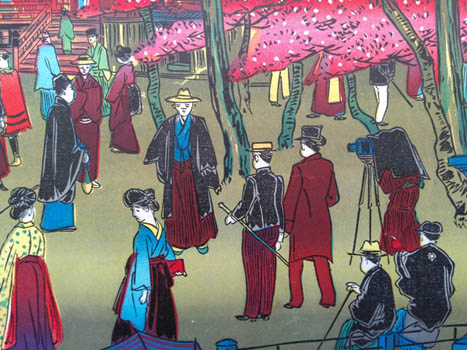
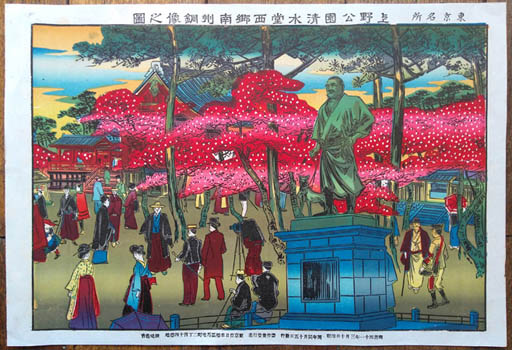


[Uenokoen Shimizu Do Saigo Nanshu Dozo no Zu] Tokyo, Tsunashima Kamekichi 1908 (Meiji 41). Colour woodcut 27x39cm. Rather good. Au$125
An almost sombre day in Ueno Park in comparison with the psychedelic colouring of cheap lithograph views of the time. Still, you can be sure that the photographer at work turned out less exciting views than this. The statue is of Saigo Takamori. Least said about him by me the better.
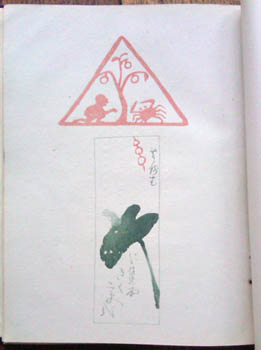
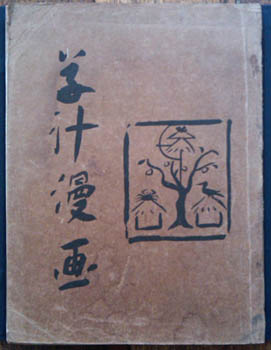
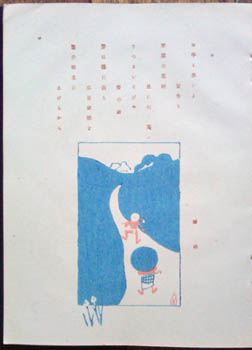
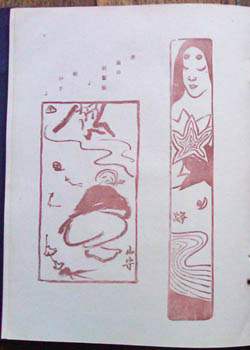

Ogawa Usen [also known as Soju Usen]. [Soju Manga]. Tokyo, Hidaka Yurindo 1908 (Meiji 41). 255x190mm publisher's printed wrapper (some wear, spine chipped); [6],136;[4],[8]pp; woodcut illustrations throughout, a few colour, most printed in sienna. Originally stapled, the staples have perished; a used but very decent copy in a modern chitsu. Au$350
First edition of Usen's first book; a facsimile was published in the seventies. A lively collection of pictures, seemingly naive at times but as Hillier said of a later book - Sangushu (1921) - "The childlike naivete of the original sketches is ... actually the acme of sophistication ... the artist is as elliptical as the poet." (Hillier; The Art of the Japanese Book).
Usen hadn't yet attained the fame that brought the quality of printing his later work has but he makes up for that here with humour and imagination. Usen studied western painting before starting his career as a newspaper and magazine illustrator and is among the best of the generation of artists born and educated with the Meiji, soaked in both the foreign and the nationalistic reaction to the foreign, and determined not to step backwards into regurgitating tradition nor become mimics of the west. Some of his late work seems refined to the point of kitsch to me but when sleek expensive art journals publish articles in English on the hitherto neglected anarchistic aims of Usen's early work we know that he has truly arrived.
OCLC finds no copy of this outside the National Diet Library.
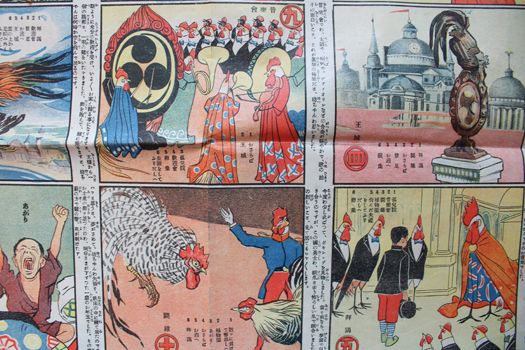
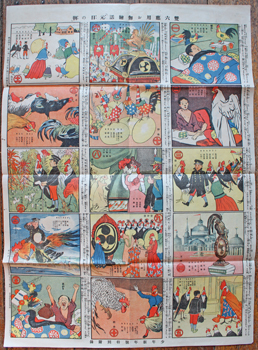
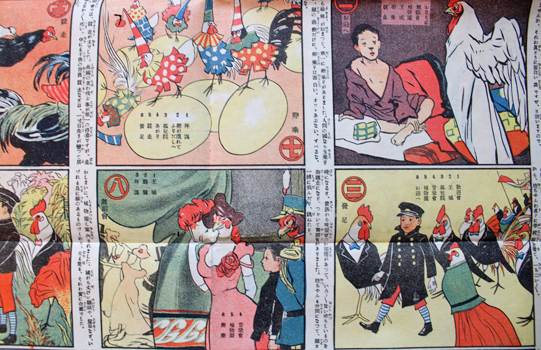


Sugoroku. ' ' [Sugoruku Oyo Otogi Ebanashi 'Ganjitsu no Asa']. Tokyo, Shonen 1909 (Meiji 42). 54x39cm colour printed broadside. A nice copy. Au$250
In this charming dream sugoroku, the new year gift from the magazine Shonen (Youth), we follow a boy's adventures in a kingdom of chickens.
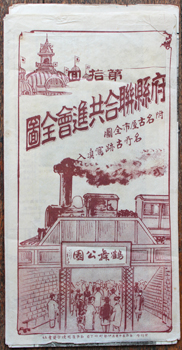
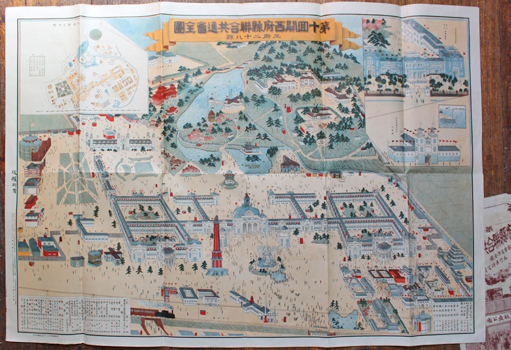
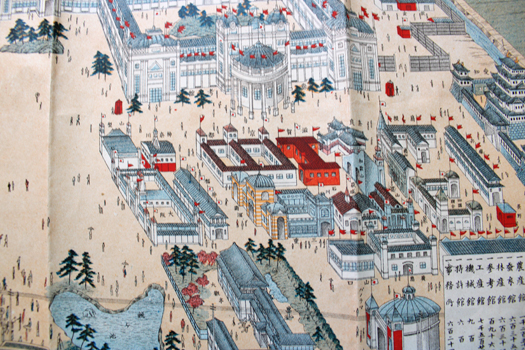
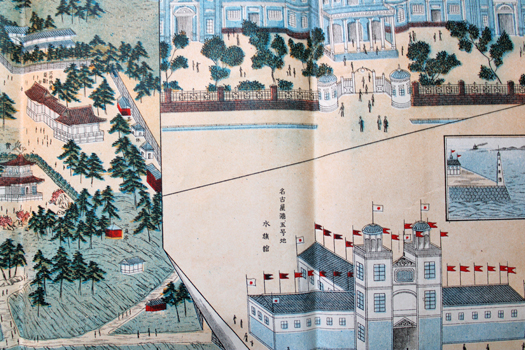

Exhibition - Nagoya 1910. [Daijikkai Kansai fuken rengen kyoshinkai zenzu]. Nagoya Yodatsu Goshigaisha 1910 (Meiji 43]. Colour lithograph 54x78cm with b/w map and photos of Nagoya on the back. Rather good with illustrated outer wrapper. Au$200
A handsome large birds-eye view. The 10th Kansai Prefectural Union Exhibition was a big jump from previous shows, held every three years since 1883. This was meant to put Nagoya on the map and so it did. Apparently more than two and a half million visitors went through.
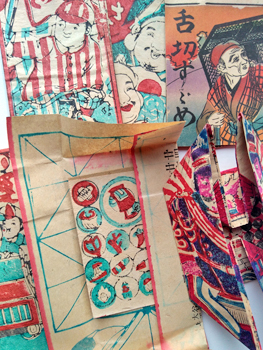
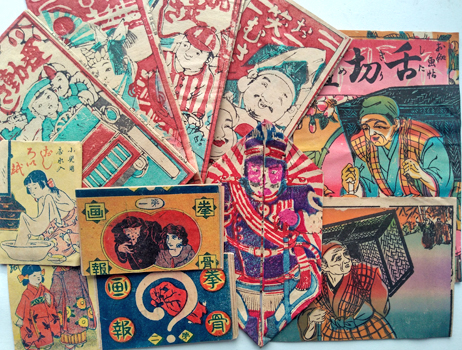
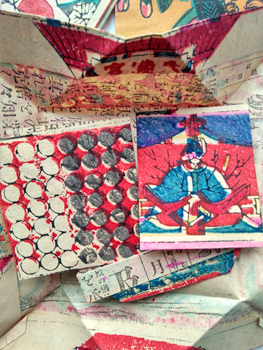
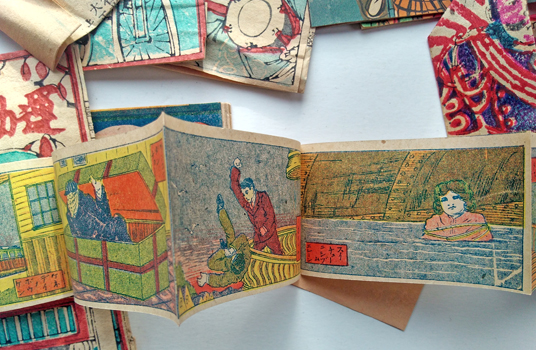

Paper toys. A gathering of eleven Taisho period cheap and flimsy paper games and booklets. n.p. 1910s to 20s. Sizes range from 8x5cm to 17x11cm closed. Obviously never used. Au$400
These look very much like they were gifts that accompanied something else or were rewards for coupons or suchlike. Five, including the origami-like soldier, fold out to be 'board' games with playing pieces inside; two are cinema like thrillers on accordian leaves and the two smallest are puzzling envelopes containing blank sheets and what looks like talcum; finally are the two booklets, smaller illustrated in black and white, larger in colour, telling the story of the Tongue Cut Sparrow.
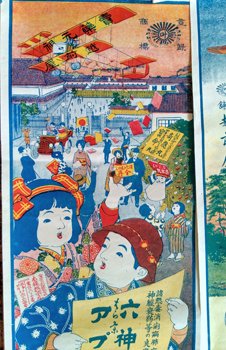
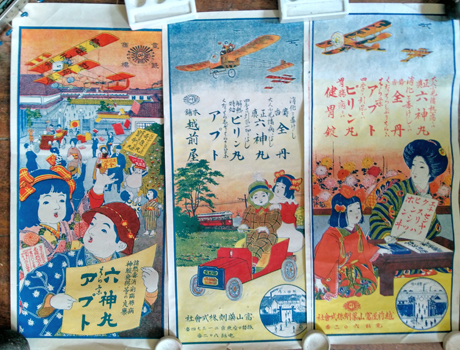
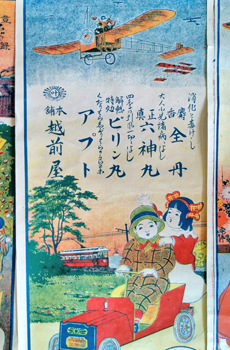
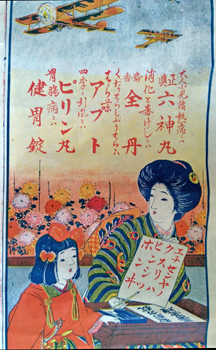

Hikifuda. - [Rokujinmaru aputo - Toyama Seizai Kabushikigaisha]. Toyama Pharmaceutical [191-?]. Three lithographs 39x18cm each. Au$300
A trio of carols to modernity, the future and whatever it is that Rokujinmaru does. Some sort of herbal medicine, presumably it makes children joyous, smart and eager to speed into the future.
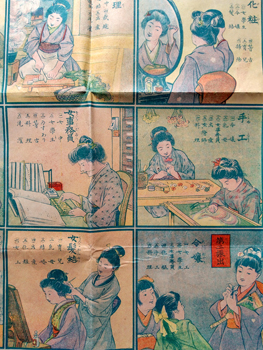
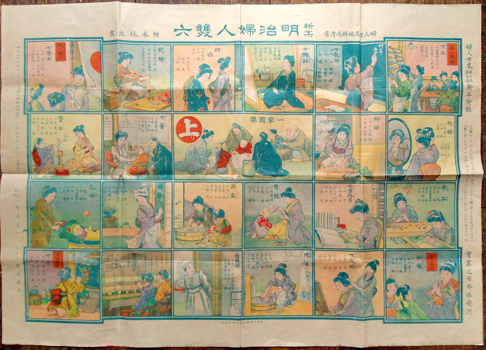

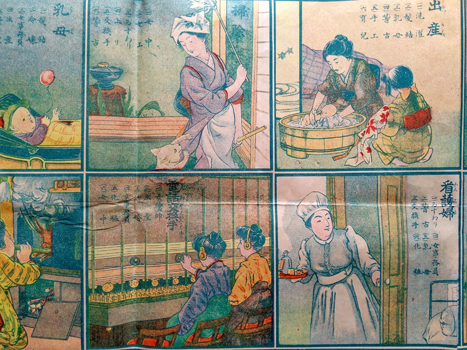

Kimoto Motoo. [Shin'an Meiji Fujin Sugoroku]. Tokyo, Fujin Sekai 1910 (Meiji 43). Colour lithograph 51x79cm. A couple of pinholes in folds, rather good. Au$300
An aspirational record of the life of the modern Meiji woman. Women do work, as telephonists, as teachers, typesetters, maybe even as a doctor. All can be balanced with a satisfying family life. This was the new year gift from the magazine, Fujin Sekai: Woman's World.
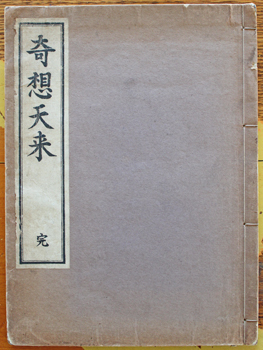
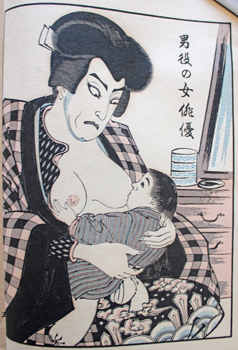
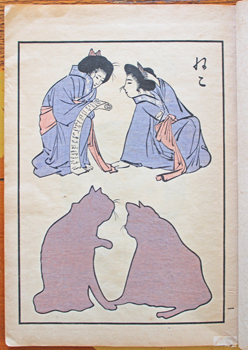
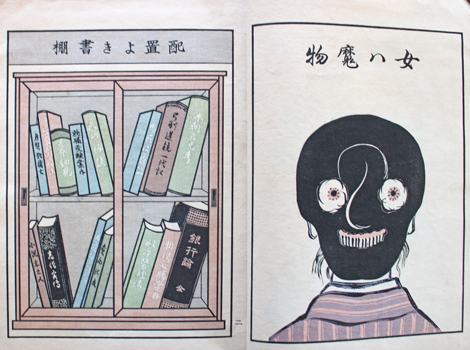

Miyatake Gaikotsu. [Kiso Tenrai]. Osaka, Gazokubunko 1910 (Meiji 43). 26x19cm publisher's wrapper with printed label; [2],30pp on double folded leaves, 16 pages in colour woodcuts, 14 in b/w. Minor signs of use, rather good. Au$900
Charming, delightful, if you like being taken aback every now and then, baffled often, and can overlook the occasional tortured pun. This is very much in the spirit of Miyatake's series of sometimes bewildering and surreal series of postcards issued as extras to his humourous newspaper, Kokkei Shimbun, in 1907. Miyatake wasn't the artist as far as I know, he was writer and publisher and directed his stable of artists to produce the sort of images he enjoyed. The kind of humour he enjoyed apparently earned him four prison sentences. He was a revered senior (senpai) of banned publications by his death. His work had been banned 43 times.
The text may solve the mysteries of several images; it may explain the point of the book, if there is one. I leave that to you. Worldcat finds no copies outside Japan.

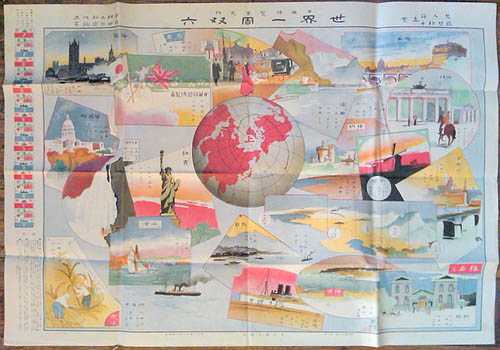
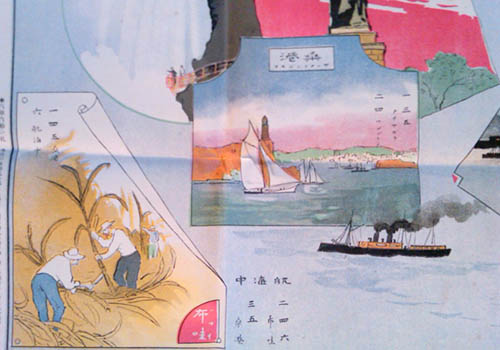
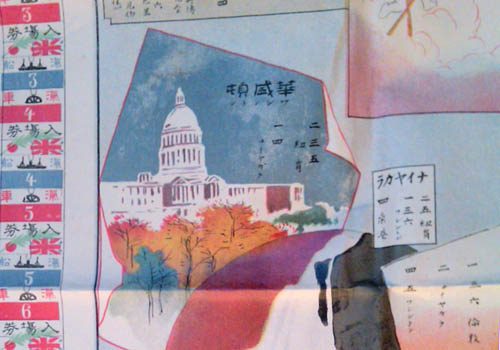

Nakamura Fusetsu. [Sekai Isshu Sugoroku]. Tokyo, Asahi Shimbun 1910 (Meiji 47). Colour printed broadside 55x78cm. Folded as issued, mild browning and signs of use. With the playing pieces intact in the margin. Au$450
An elegant sugoroku - racing game - issued by the newspaper Asahi Shimbun to celebrate the 1910 Anglo-Japanese Exhibition in London. Nakamura was a star of the generation that studied western painting and went on to forge a new style of Japanese painting, enlivening magazine work and book illustration.
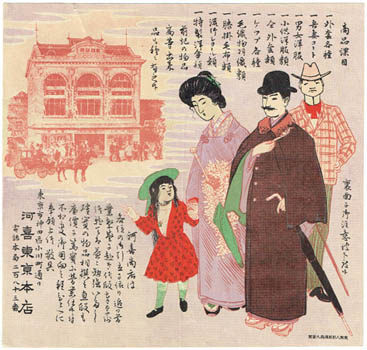
Hikifuda - fashion. . A small hikifuda - handbill - advertising fashion from Kawaki Shoten in Ogawamachi in Tokyo. Tokyo [c1910?]. Colour lithograph broadsheet 18x19cm. Illustration on one side, text in blue on the other. An old crease. Au$65
Small but chic. Is the young dandy wanting the stylish but undeniably bourgeois family to move on or is that merely a dandy's customary expression of disdain?
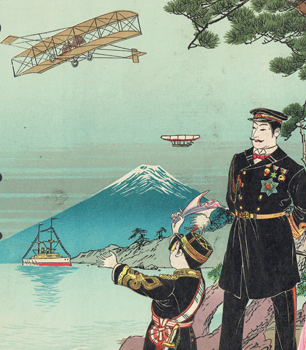
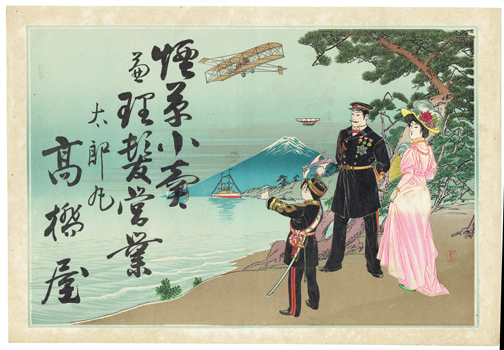
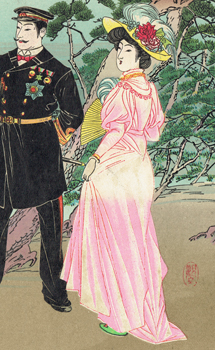
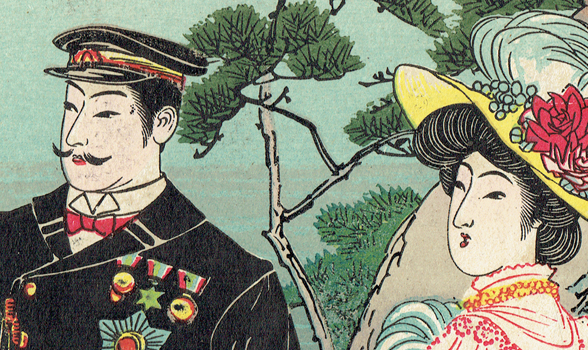

Hikifuda. ... ... [Takahashiya ... Taromaru ...]. n.p. [c1910?]. 26x38cm colour woodcut. Margins browned. Au$125
I don't know what Takahashiya sold, I'm sorry, but I can tell you that Taromaru is in Toyama and that this patriotic hikifuda celebrates the royal family who in turn celebrate Japan taking to the air. That's the crown prince, soon to be emperor Taisho and some family: wife and presumably his oldest child, Hirohito.
These hikifuda - small posters or handbills - were usually produced with the text panel blank. The customer, usually a retailer, had their own details over printed, so the same image might sell fine silk or soy sauce.

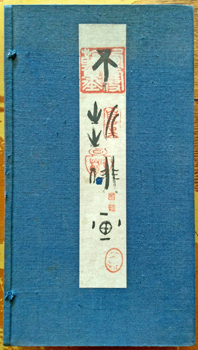
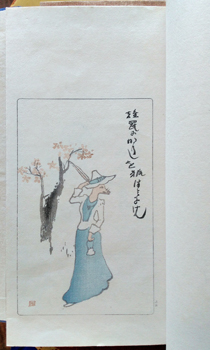
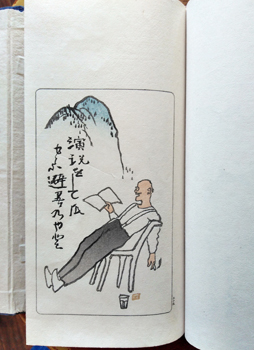

Nakamura Fusetsu, Takahama Kyoshi, Kawahigashi Hekigodo & Natsume Soseki. [Fusetsu Haiga]. Tokyo, Kokado 1910 (Meiji 43). Two volumes 30x17cm publisher's cloth* wrappers, title labels (the first a touch nibbled); 20 colour woodcuts by Fusetsu in each volume plus woodcut titles and another colour print in the second; Natsume Soseki's preface printed as a manuscript in umber. In a cloth case missing its clasps, title label stamped with five red seals including what looks to be Fusetsu's and at least one of the other contributor's own seals (that on the title of the second volume - is it one of Soseki's innumerable seals?). A remarkably bright copy of a book prone to foxing. Au$800
Is this a large paper or deluxe copy? The first thing that struck me when these arrived was how tall they are and I can't find a record of any other copy much less than an inch shorter (and thinner when a clear enough picture is available). Or is it just that copies measured and catalogued as first editions aren't? This copy does not have and never had the publisher's announcements and colophon at the end of each volume like the copy reproduced by the NDL.
Haiga - the mix of picture and haiku - is by 1910 very old school and Fusetsu's drawings have a direct lineage to Buson. But Fusetsu was a star of the generation that studied western painting and went on to forge a new style of Japanese painting which, given ink and paper and freed from the weight of oil, canvas and the academy, breathed life back into Japanese drawing with the same sharp eye but more affection than their European contemporaries, making the best of those draughtsmen look a bit mean and studied.
*Neither can I find another copy bound with what looks like a loose weave muslin.

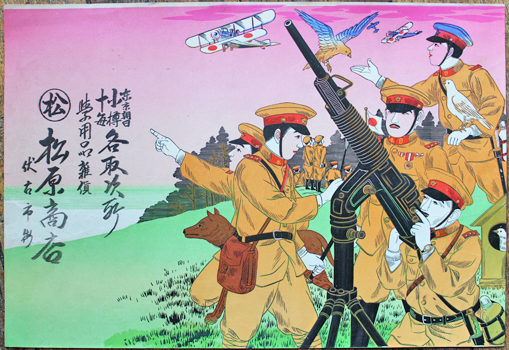
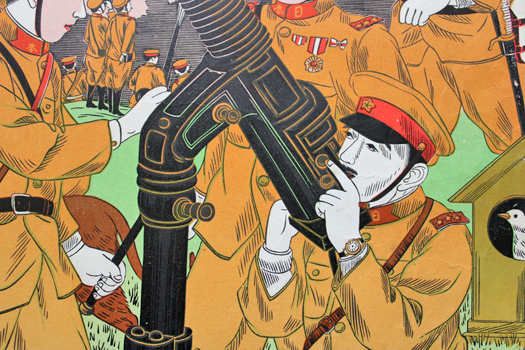

Hikifuda. ... [Gakuyohin ...]. np [191-?]. Colour lithograph 26x38cm. A nice copy. Au$135
Presumably this hallucinatory hikifuda dates from around the first world war. At first I feared that the 'clay' of 'clay pigeons' had been lost in translation but these dopey looking young soldiers are concentrating rather than thick or stoned. The young men and animals of Japan are prepared.
Hikifuda - small posters or handbills - were usually produced with the text panel blank. The customer, usually a retailer, had their own details over printed, so the same image might sell fine silk or soy sauce. Here, I believe, the products on offer are school supplies.

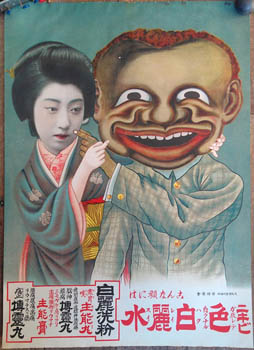

Teruha toiletry poster. [Hakuresui or Hakureisui]. A shop poster for Hakuresui toiletry to whiten the skin and remove blemishes. Osaka, Takegaki Shokai c1910. Colour lithograph 53x38cm on quite heavy paper. A couple of tiny edge chips, a near invisible repair to a short tear; a rather good copy. Au$1200
Among the myriad images that use race superiority and fear to sell goods - particularly soaps, toiletries and cosmetics - this is the weirdest and most hypnotic that I've ever seen. The weirdness intensifies if you know that the model is Teruha, maybe Japan's most famous geisha and pin-up girl at the end of the Meiji and through the Taisho period. Born Tatsuko Takaoka, in this poster she is about 14 and has possibly graduated from her apprentice name, Chiyoha. Sold by her father at 12, her virginity was soon sold to the president of the Osaka stock exchange and by the time she was 14 she had been engaged to one wealthy business man, promised to another and had a secret affair with an actor. The extended left pinkie finger must be a joke about her misguided sacrifice to love which earnt her yet another name: the Nine Fingered Geisha.
Before and after - or with and without - comparisons were nothing new in Japanese advertising. Neither were celebrities: courtesan prints sold patent medicines long before the Americans arrived and Bismarck adorned adverts for a patent syphilis cure that did for medicine what Bismarck did for Germany. Darkie - coon, nigger, whatever you want to call it - advertising images were obviously not unknown but neither can they have been familiar enough to be taken for granted and reproduced to the American and British formula in the way that the jazz age negro became a standard pattern to be played with by artists and designers in Japan as everywhere else. There is more than hint of a jovial jokai, tengu, spirit or minor god here, but for that suit.
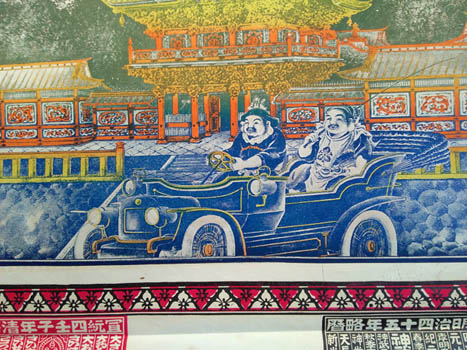
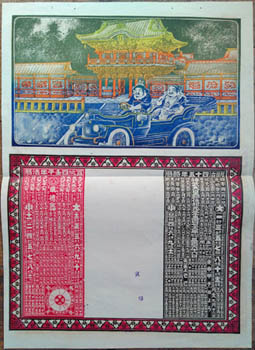

Specimen Hikifuda. Hikifuda of lucky gods driving a motor car. n.p. [1911]. Colour lithograph and woodcut 52x38cm. Stab holes in the margin show it was once in an album. Horizontal fold; quite good. The picture is lithographed, the calendar woodcut. Au$200
An extra psychedelic extravaganza in experimental colour showing lucky god Ebisu being chauffered by Daikokuten. These two did embrace modernity and had very good tailors as can be seen when the occasion demanded a smart suit or an even more smart uniform. Here they haven't dressed; it's just two friends on an outing. Maybe a joyride. I wonder whether it was good luck to have these two snaffle your car.
These hikifuda - small posters or handbills - were usually produced with the text panel blank. The customer, usually a retailer, had their own details over printed. The handy calendar is for 1912.
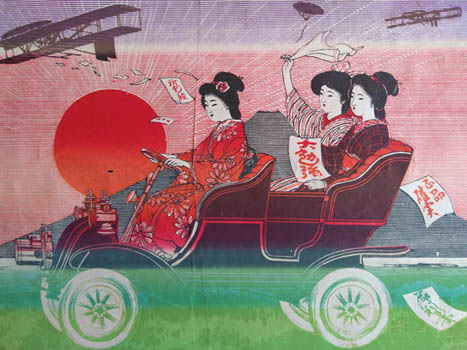


Hikifuda. Hikifuda of a woman driving a motor car. n.p. [1912]. Colour woodcut 53x37cm. Old folds, rumpling and a couple of small repairs. Au$800
A while ago I offered a 1914 printed hikifuda something like this and asked whether anyone had seen an earlier picture of a Japanese woman driving a car? Now the answer is: I have. Cars and planes were the password for modernity through the Taisho, especially in advertising like this, but sleek women were driven by sleek husbands or chauffeurs. This is radical stuff. It's not until well into the twenties that women behind the wheel became common. Common but not really acceptable. Cars were driven by Mogas - modern girls - louche young women with bobbed hair and short skirts: flappers. The history of early Japanese women motorists, in English, is blank. Can some expert out there help?
These hikifuda - small posters or handbills - were usually produced with the text panel blank. The customer, usually a retailer, had their own details over printed. In this case it was Tamachi Taya of Kaneko-mura. The handy calendar is for 1913.
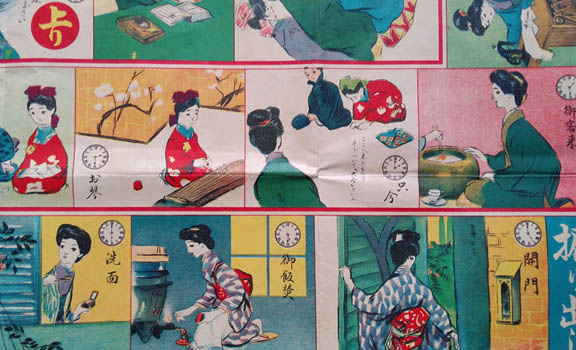
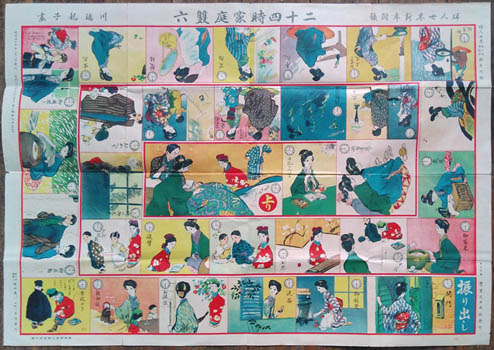
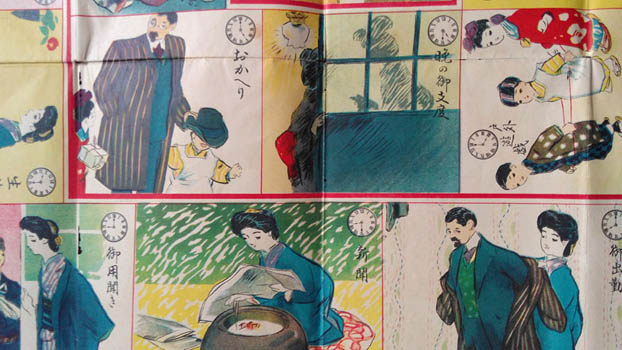
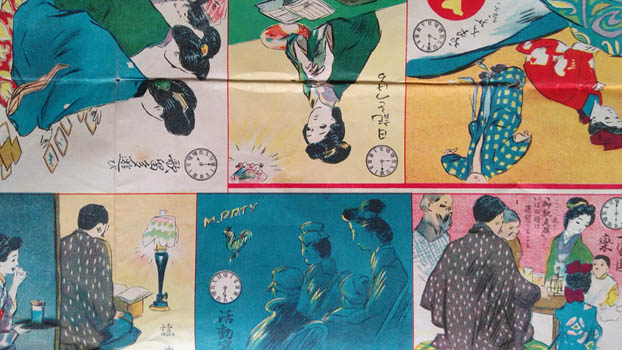

Kawabata Ryushi [Nijuyon Toki Katei]. Tokyo, Fujin Sekai 1912 (Meiji 45). Colour broadside 54x78cm. A bit used, a few small holes in folds. Au$400
The new year gift from the magazine Fujin Sekai - Woman's World - charting the day in the busy but calm and most decorative life of the successful woman - wife and mother.
Kawabata's career took a curious turn during a 1913 stay in America to study western painting. Apparently he was so impressed with the Japanese art he saw in Boston he switched to being a Nihonga painter. Still, he remained being an illustrator for magazines for quite some time. As did most of the early to mid 20th century artists now revered.
  1 2 [3] 4 5 6 1 2 [3] 4 5 6   |